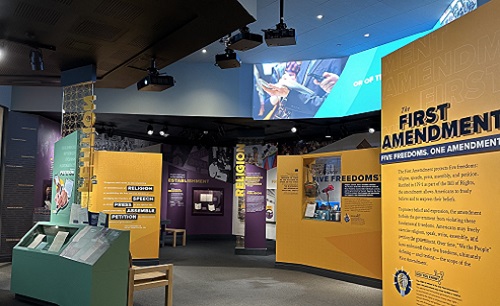This activity is part of Module 6: Separation of Powers and Federalism from the Constitution 101 Curriculum.
Complete the questions in the following quiz to test your knowledge of basic ideas and concepts covered in this module.
- With the new Constitution, the framers sought to create a balance between _______.
- The national government and state governments
- The three branches of the national government
- A stronger national government and the liberties of the people
- All of the above
- In the founders’ view, the best way to protect the unalienable rights promised by the Declaration of Independence was ___________.
- A Constitution founded on the separation of powers
- A virtuous president like George Washington
- A very weak central government
- To establish a true democracy
- Separation of powers refers to the fact that _________.
- The Constitution distributes power among the three branches of government
- The American colonies had recently separated from the British government
- The smaller states wanted separate power from large states
- The new national government could take away certain powers
- What are the three different branches of government outlined in the Constitution?
- Electoral, Administrative, Judicial
- Legislative, Executive, Judicial
- Legislative, Presidential, Administrative
- Legislative, Executive, Parliamentary
- The Constitution established a system of checks and balances, which grants ______.
- Only Congress the power to check other branches
- Only the president the power to check other branches
- Only the Supreme Court the ability to check the other branches
- Each branch the power to check abuses by the other branches
- Federalism is the word used to describe the Constitution’s system of granting political power __________.
- By giving all political power to the federal government
- By giving all political power to the states
- By dividing political power between the national government and the states
- To the other branches, in theory, but retaining all real power under the president
- The Spirit of the Laws, which articulated the importance of the separation of powers, was written by _________.
- James Madison
- Montesquieu
- John Adams
- John Locke
- According to Montesquieu, what happens when the legislative and executive powers are united in the same person, or in the same body of magistrates?
- This is an ideal form of government.
- The executive will have great power to help the people.
- There can be no liberty.
- People will know they can trust the legislature if the president is involved, too.
- According to John Adams’s Thoughts on Government, what was the very definition of a republic?
- The definition he outlined in the Declaration of Independence.
- Rule directly by the people.
- An empire of men.
- An empire of laws and not of men.
- James Madison outlined his explanation and defense of the Constitution’s separation of powers in which document?
- The Declaration of Independence
- The Virginia Declaration of Rights
- Federalist No. 51
- The Spirit of the Laws
- According to Madison, in a good government, “__________ must be made to counteract ambition”?
- A powerful police force
- Ambition
- Difficult election processes
- Delays
- What was true about the delegates to the Constitutional Convention?
- They crafted a stronger central government than the one that came before it.
- It created a much weaker central government.
- They were concerned about the central government being too powerful.
- Both A and C
- What is the primary job of the legislative branch? (Article I)
- To make laws
- To enforce laws
- To interpret laws
- All of the above
- What is the primary job of the executive branch? (Article II)
- To make laws
- To enforce laws
- To interpret laws
- All of the above
- What is the primary job of the judicial branch? (Article III)
- To make laws
- To enforce laws
- To interpret laws
- All of the above
- This series of essays defended the Constitution and the notion of separation of powers:
- The Silence Dogood Letters
- The Federalist Papers
- The Adams-Jefferson Correspondence
- The letters from Brutus
- Which of these is a famous quote by James Madison?
- Greed is good.
- If men were angels, no government would be necessary.
- If you ain’t first, you’re last.
- Men are angels, so no government is necessary.
- Which of these jobs exercises executive power?
- The mayor of your town
- The governor of your state
- The president
- All of the above
- Which of these functions of government is an example of checks and balances?
- Vetoing a law
- Rejecting a judicial nominee
- Impeachment
- All of the above
- Which part of the federal government has the power to hear legal cases and strike down laws which are unconstitutional?
- The judicial branch
- The House of Representatives
- The Senate
- The executive branch
Answer Key: D, A, A, B, D, C, B, C, D, C, B, D, A, B, C, B, B, D, D, A






